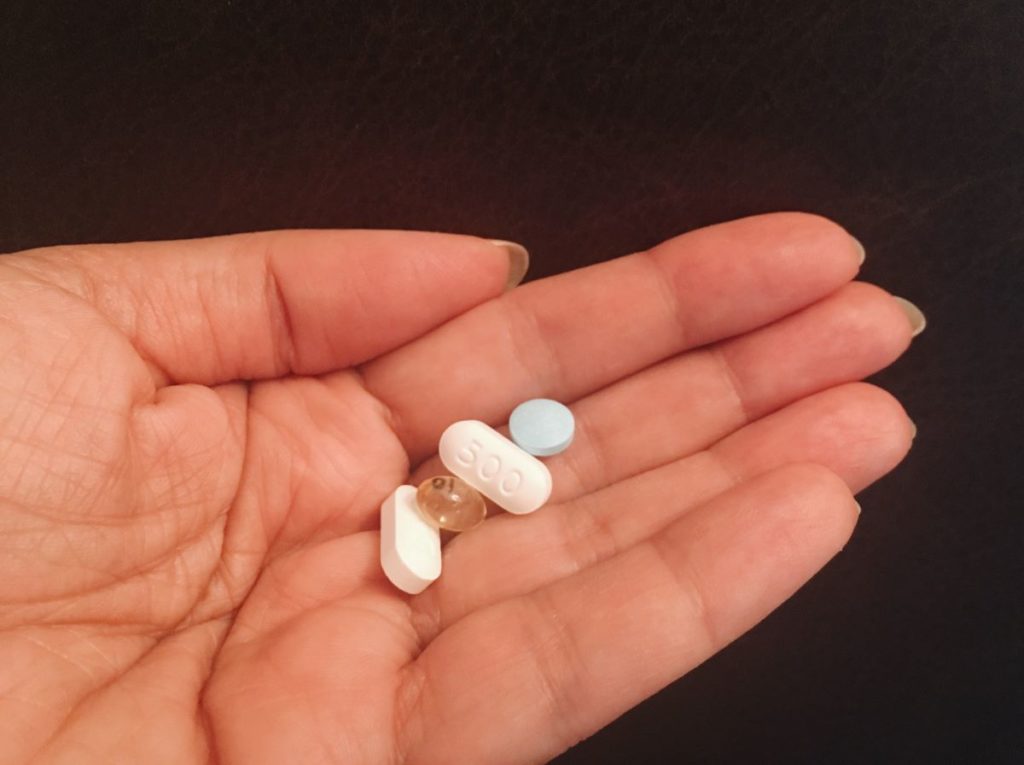
Antipsychotic medication is a key part of the treatment of schizophrenia, being effective in acute treatment (Haddad et al., 2018) and in reducing the risk of relapse (Leucht et al., 2012). However, this effectiveness comes at the price of side effects.
Previous meta-analyses have ranked the relative risk of antipsychotics for a range of side effects during acute treatment, including weight gain (Leucht et al., 2013). However, they have not investigated a comprehensive range of metabolic side effects including glucose intolerance and dyslipidaemia.
A recent network meta-analysis by a UK research group has addressed this shortcoming (Pillinger et al., 2020). It ranks 18 antipsychotics from best to worst on their impact on seven metabolic parameters. The study also identifies predictors for metabolic dysfunction and explores the relationship between symptom improvement in schizophrenia and the degree of metabolic change.
This is an important area for patients and clinicians. Weight gain can cause distress, stigma and poor medication adherence, which is a major risk factor for relapse (Fakhoury et al., 2001; Higashi et al., 2013). The risks of abdominal obesity, diabetes, hypertriglyceridemia, low HDL cholesterol and metabolic syndrome are two to four times higher in those with schizophrenia than in the general population (Vancampfort et al., 2013). These increased risks are multifactorial with genetics, lifestyle and medication playing a part (Cooper et al., 2016). People with schizophrenia have a reduced life expectancy of approximately 15 years compared to the general population (Hjorthøj et al., 2017) and cardiovascular disease is a major contributor to this (Crump et al., 2012).

Patients often regard weight gain as one of the most distressing side effects of antipsychotics.
Methods
The authors searched electronic databases and included blinded randomised controlled trials (RCTs) that compared antipsychotic monotherapy to placebo in the acute treatment of schizophrenia or related disorders (schizoaffective, schizophreniform and delusional disorders). Acute treatment was defined as 6 weeks (if 6-week data was not available, the data closest to that time point was used).
Change from study baseline to endpoint was extracted for seven metabolic measures:
- Body weight
- Body mass index (BMI)
- Total cholesterol concentration
- Low-density lipoprotein (LDL) cholesterol concentration
- High-density lipoprotein (HDL) cholesterol concentration
- Triglyceride concentration
- Glucose concentration
All blood tests related to fasting conditions. The authors summarised the results of the meta-analysis in a series of forest plots which used placebo as the reference. They used meta-regression to examine the effect of potential moderators on degree of metabolic change. They examined the association between metabolic change and improvement in overall psychopathology as assessed by change on the Positive and Negative Syndrome Scale (PANSS) or Brief Psychiatric Rating Scale (BPRS).
Results
One hundred RCTs including data from 25,952 participants were included. This related to 18 antipsychotics: amisulpride, aripiprazole, asenapine, brexpiprazole, cariprazine, clozapine, flupenthixol, fluphenazine, haloperidol, iloperidone, lurasidone, olanzapine, quetiapine, risperidone, paliperidone, sertindole, ziprasidone, and zotepine. Risperidone and paliperidone were analysed together (paliperidone is the active metabolite of risperidone). The median duration of antipsychotic treatment was 6 weeks (range 2-13 weeks). The average age of participants was 35 years and men made up 58% of the sample. The number of antipsychotics for which data was available varied depending on the metabolic parameter considered. This ranged from BMI and LDL cholesterol (9 antipsychotics) to body weight (18 antipsychotics).
The 18 antipsychotics differed markedly in their metabolic effects. For each of the seven metabolic parameters there were some antipsychotics that did not differ significantly from placebo and others that led to significant impairment of regulation. A few antipsychotics improved some aspects of metabolic regulation compared to placebo; cariprazine reduced LDL cholesterol, lurasidone reduced glucose and aripiprazole and brexpiprazole increased HDL cholesterol. The largest metabolic disturbances, across virtually all parameters, were seen with olanzapine and clozapine.
Higher baseline weight and male sex were associated with greater increases in fasting glucose. Non-white ethnicity, compared to white ethnicity, was associated with greater increases in total cholesterol. Baseline characteristics did not influence other metabolic parameters. Symptom improvement was associated with increased BMI, weight, total-cholesterol and LDL cholesterol and decreased HDL cholesterol. This association was strongest for BMI (r=0·84, p<0·0001).

Symptom improvement was associated with greater metabolic dysregulation, including an increased BMI (body mass index).
Conclusions
- Clinically significant changes in metabolic parameters occur within 6 weeks of starting treatment with some antipsychotics
- Antipsychotics vary in their metabolic effects with clozapine and olanzapine causing the most marked dysregulation on most parameters. The authors concluded that: “aripiprazole, brexpiprazole, cariprazine, lurasidone, and ziprasidone are associated with the best metabolic outcomes.”
- Higher baseline weight, male sex and non-white ethnicity predicts greater dysregulation of some metabolic parameters
- Greater symptom improvement was associated with greater dysregulation of several parameters including weight and BMI.

Clozapine and olanzapine caused the most marked metabolic dysregulation.
Strengths and limitations
Strengths of the study include:
- A large data set; 100 RCTs with data from 25,952 individuals
- The systematic review was conducted independent of the funding bodies and there was no funding/involvement from the pharmaceutical industry
- The search was restricted to randomised trials and so potential confounders that could affect metabolic outcomes should be equally distributed between treatment groups
- The authors followed PRISMA guidance for reporting.
Limitations of the study include:
- Only 18 of the 100 studies showed a low risk of bias
- The results relate to short term metabolic disturbance (median study duration = 6 weeks). Further studies are needed to assess the relative risk of antipsychotics affecting metabolic function in the longer term
- Ethnicity was analysed as white and non-white and it would be helpful to have data on specific ethnic groups
- The three first generation antipsychotics (FGAs) included (flupenthixol, fluphenazine, haloperidol) are high potency drugs and so the study does not inform about the relative risk of metabolic side effects of low potency FGAs. Although comparative data is limited, previous work shows that chlorpromazine, a low potency FGA, has a high risk of causing metabolic disturbance (Leucht et al., 2013; Thonnard-Neumann 1968)
- The metabolic data for flupenthixol and fluphenazine was limited to weight gain. The paucity of data on metabolic side effects of FGAs is because this was not a major focus of interest in the 1950s and 1960s which is when most FGAs were developed and entered clinical practice.

Only 18 of the 100 RCTs included in the review showed a low risk of bias.
Implications for practice
The study highlights the importance of following guidelines on metabolic monitoring during antipsychotic treatment. For example, guidelines from the British Association for Psychopharmacology (Cooper et al., 2016) recommend that metabolic parameters should be measured before starting an antipsychotic, or as soon as possible afterwards, and at regular intervals thereafter. The frequency of monitoring depends on the parameter in question. For example, it is recommended that BMI is measured as a minimum, once every 4 weeks for the first 12 weeks of treatment, and then at 6 months and at least annually thereafter. Glycated haemoglobin (HbA1c) and lipid profile should be measured at 12 weeks, 6 months and then annually.
The study shows that antipsychotics differ markedly in their risk of causing metabolic side effects. The hierarchies of risk for specific metabolic side effects may assist clinicians and patients choosing which antipsychotic drug to use. Choices need to be made on an individual patient basis, but this is often difficult as the relative risk of a wide range of side effects needs to be considered. For example, in this study haloperidol was the drug with the lowest risk of weight gain and BMI increase, yet other studies indicate haloperidol has a high liability to cause extrapyramidal side effects and raised prolactin (Leucht et al., 2013).
Although this study did not show an association between baseline weight and degree of weight gain, some observational studies and RCTs have shown that lower baseline weight/BMI is associated with greater weight gain during antipsychotic treatment (e.g. Bushe et al., 2013; Xiang et al., 2011). This could reflect regression to the mean or prior antipsychotic use. It may have led some clinicians to regard drugs with a higher propensity for weight gain, for example olanzapine, as being ‘safer’ in terms of metabolic effects in those with elevated BMI. This study shows this is a flawed assumption, as higher baseline weight is associated with greater antipsychotic-induced elevation of blood glucose.
Most studies show that antipsychotic use, versus no use, is associated with reduced mortality in people with schizophrenia. This includes the FIN20 study, a Finish nationwide cohort study of people with schizophrenia with up to 20 years of follow-up (Taipale et al., 2020). It is the largest and longest observation study to investigate this area. It found that antipsychotic treatment, especially clozapine, compared to no antipsychotic treatment was associated with reduced all-cause mortality, suicide mortality and cardiovascular mortality. The results for cardiovascular and overall mortality may seem paradoxical given the metabolic side effects of antipsychotics, but there are several possible explanations. In particular, that antipsychotics improve psychiatric symptoms, which may allow people to lead healthier lifestyles (e.g. in terms of diet, smoking, activity levels) and to better engage in physical health care leading to improved secondary and tertiary prevention of cardiovascular and other physical illnesses.
Clozapine remains the treatment of choice in treatment resistant schizophrenia, despite its high metabolic risk, due to its unique efficacy in this subgroup of patients (Siskind et al., 2016).

The results of this review may help clinicians and patients to choose which antipsychotic drug to use.
Statement of interests
In the last 2 years, P.H. has received lecture fees from Lundbeck, NewBridge Pharmaceuticals, Otsuka and Sunovion. He is a co-author of the 2016 British Association for Psychopharmacology (BAP) guidelines on the management of weight gain, metabolic disturbances and cardiovascular risk associated with psychosis and antipsychotic drug treatment. S.O. has no competing interests.
Links
Primary paper
Pillinger T, McCutcheon RA, Vano L, Mizuno Y, Arumuham A, Hindley G, Beck K, Natesan S, Efthimiou O, Cipriani A, Howes OD (2020). Comparative effects of 18 antipsychotics on metabolic function in patients with schizophrenia, predictors of metabolic dysregulation, and association with psychopathology: a systematic review and network meta-analysis. Lancet Psychiatry 7(1):64-77.
Other references
Bushe CJ, Slooff CJ, Haddad PM, Karagianis JL (2013). Weight change by baseline BMI from three-year observational data: findings from the Worldwide Schizophrenia Outpatient Health Outcomes Database. J Psychopharmacol. 27(4):358-65.
Cooper SJ, Reynolds GP; With expert co-authors (2016). BAP guidelines on the management of weight gain, metabolic disturbances and cardiovascular risk associated with psychosis and antipsychotic drug treatment. J Psychopharmacol. 30(8):717-48.
Crump C, Winkleby MA, Sundquist K, Sundquist J (2013). Comorbidities and mortality in persons with schizophrenia: a Swedish national cohort study. Am J Psychiatry 170(3):324-33
Fakhoury WK, Wright D and Wallace M (2001). Prevalence and extent of distress of adverse effects of antipsychotics among callers to a United Kingdom National Mental Health Helpline. Int Clin Psychopharmacol 16: 153–162.
Haddad, P. M., & Correll, C. U. (2018). The acute efficacy of antipsychotics in schizophrenia: a review of recent meta-analyses. Ther Adv Psychopharmacol, 8(11), 303-318. doi:10.1177/2045125318781475.
Higashi, K., Medic, G., Littlewood, K. J., Diez, T., Granstrom, O., & De Hert, M. (2013). Medication adherence in schizophrenia: factors influencing adherence and consequences of nonadherence, a systematic literature review. Ther Adv Psychopharmacol, 3(4), 200-218. doi:10.1177/2045125312474019.
Hjorthøj C, Stürup AE, McGrath JJ, Nordentoft M (2017). Years of potential life lost and life expectancy in schizophrenia: a systematic review and meta-analysis. The Lancet Psychiatry 4(4):295–301.
Leucht S, Tardy M, Komossa K, et al. (2012). Antipsychotic drugs versus placebo for relapse prevention in schizophrenia: a systematic review and meta-analysis. Lancet 379: 2063–2071.
Leucht S, Cipriani A, Spineli L, et al (2013). Comparative efficacy and tolerability of 15 antipsychotic drugs in schizophrenia: a multiple treatments meta-analysis. Lancet 382:951–962.
Siskind D, McCartney L, Goldschlager R et al. (2016). Clozapine v. first- and second-generation antipsychotics in treatment-refractory schizophrenia: systematic review and meta-analysis. Br J Psychiatry 209:385–392.
Taipale H, Tanskanen A, Mehtälä J, Vattulainen P, Correll C, Tiihonen J (2020). 20-year follow-up study of physical morbidity and mortality in relationship to antipsychotic treatment in a nationwide cohort of 62,250 patients with schizophrenia (FIN20). World Psychiatry 19(1):61-68.
Thonnard-Neumann E (1968). Phenothiazines and diabetes in hospitalized women. Am J Psychiatry 124(7):978-82
Vancampfort D, Wampers M, Mitchell AJ, Correll CU, De Herdt A, Probst M, De Hert M (2013). A meta-analysis of cardio-metabolic abnormalities in drug naïve, first-episode and multi-episode patients with schizophrenia versus general population controls. World Psychiatry 12(3):240-50.
Xiang YT, Wang CY, Ungvari GS, Kreyenbuhl JA, Chiu HF, Lai KY, Lee EH, Bo QJ, Dixon LB (2011). Weight changes and their associations with demographic and clinical characteristics in risperidone maintenance treatment for schizophrenia. Pharmacopsychiatry 44(4):135-41
Photo credits
- Photo by Hal Gatewood on Unsplash
- Photo by i yunmai on Unsplash
- Photo by Paulo Carrolo on Unsplash
- Photo by pina messina on Unsplash
- Photo by Bud Helisson on Unsplash
- Photo by National Cancer Institute on Unsplash

I was helped 3 years ago by Professor Peter Haddad with a mental health and best practice seminar at Burnley Football club. Peter is very good person; we also went on Radio Lancashire together. I wanted to send him an email to let him know about some work I am involved with at the University of Lancaster. Please could Peter email me.
Paul – it was good to work with you on those mental health public engagement projects. I look forward to hearing about your recent work at the University of Lancaster.
Hi Paul,
Please feel free to send me an email, and I’d be happy to share Peter’s contact details with you so you can speak to him more about this:
laura.hemming@nationaleflservice.net
Thanks!
Laura